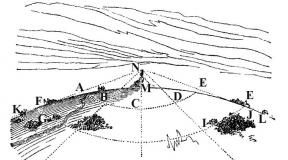The Bassa Darkie technique reveals. Bassa-Darki technique for diagnosing aggressiveness: description
Scales: physical aggression, indirect aggression, irritability, negativism, touchiness, suspicion, verbal aggression, guilt
Purpose of the test
When creating their questionnaire differentiating manifestations of aggression and hostility, A. Bass and A. Darkey identified the following types of reactions:
.Physical aggression- use of physical force against another person.
. Indirect- aggression directed in a roundabout way at another person or not directed at anyone.
. Irritation- readiness to express negative feelings at the slightest excitement (hot temper, rudeness).
.Negativism- oppositional behavior from passive resistance to active struggle against established customs and laws.
. Resentment- envy and hatred of others for real and fictitious actions.
.Suspicion- ranging from distrust and wariness of people to the belief that other people are planning and causing harm.
.Verbal aggression- expression of negative feelings both through form (screaming, screeching) and through the content of verbal responses (curses, threats).
. Guilt- expresses the subject’s possible belief that he is a bad person, that he is doing evil, as well as the remorse he feels.
The following principles were used when compiling the questionnaire:
The question can only apply to one form of aggression.
. questions are formulated in such a way as to weaken to the greatest extent the influence of public approval of the answer to the question.
The questionnaire consists of 75 statements to which the subject answers “yes” or “no.”
Test
1. At times I cannot control the urge to harm others.
2. Sometimes I gossip about people I don’t like.
3. I get irritated easily but calm down quickly.
4. If they don’t ask me nicely, I won’t do it.
5. I don't always get what I'm supposed to.
6. I don't know what people say about me behind my back.
7. If I don't approve of my friends' behavior, I let them feel it.
8. Whenever I deceived someone, I felt painful remorse.
9. It seems to me that I am incapable of hitting a person.
10. I never get angry enough to throw things.
11. I am always forgiving of other people's shortcomings.
12. If I don’t like a rule, I want to break it.
13. Others know how to almost always take advantage of favorable circumstances.
14. I am wary of people who treat me a little more friendly than I expected.
15. I often disagree with people
16. Sometimes thoughts come into my mind that I am ashamed of.
17. If someone hits me first, I won’t hit him back.
18. When I get irritated, I slam doors.
19. I'm much more irritable than I think
20. If someone imagines himself to be a boss, I always act against him
21. I'm a little sad about my fate
22. I think a lot of people don't like me
23. I can't resist arguing if people don't agree with me.
24. People who shirk work should feel guilty.
25. Anyone who insults me and my family is asking for a fight.
26. I'm not capable of rude jokes.
27. I get angry when people make fun of me.
28. When people pretend to be bosses, I do everything so that they do not become arrogant
29. Almost every week I see someone I don't like
30. Quite a lot of people are jealous of me
31. I demand that people respect me
32. I feel depressed because I don’t do enough for my parents.
33. People who constantly harass you are worth getting punched on the nose.
34. I am never gloomy with anger
35. If people treat me worse than I deserve, I don’t get upset.
36. If someone makes me angry, I don't pay attention.
37. Although I don’t show it, I sometimes feel jealous.
38. Sometimes I feel like people are laughing at me
39. Even if I'm angry, I don't use “strong” language.
40. I want my sins to be forgiven
41. I rarely fight back, even if someone hits me.
42. When things don’t go my way, I sometimes get offended.
43. Sometimes people irritate me just by their presence
44. There are no people I truly hate
45. My principle: “Never trust “strangers”
46. If someone annoys me, I am ready to say what I think about him
47. I do a lot of things that I later regret.
48. If I get angry, I might hit someone
49. Since childhood, I have never shown outbursts of anger.
50. I often feel like a powder keg ready to explode.
51. If everyone knew how I felt, I would be considered difficult to work with.
52. I always think about the secret reasons that make people do something nice for me.
53. When people yell at me, I start yelling back.
54. Failures make me sad
55. I fight no less and no more often than others
56. I can remember times when I was so angry that I grabbed something that came into my hand and broke it.
57. Sometimes I feel like I'm ready to start a fight first.
58. Sometimes I feel like life is treating me unfairly.
59. I used to think that most people told the truth, but now I don’t believe it.
60. I only swear out of anger.
61. When I do wrong, my conscience torments me.
62. If I need to use physical force to protect my rights, I use it
63. Sometimes I express my anger by slamming my fist on the table.
64. I can be rude to people I don’t like.
65. I have no enemies who would like to harm me
66. I don’t know how to put a person in his place, even if he deserves it.
67. I often think that I have lived wrong
68. I know people who can get me into a fight.
69. I don't get upset over little things.
70. It rarely occurs to me that people are trying to make me angry or insult me.
71. I often only threaten people, although I have no intention of carrying out the threats.
72. I've become a bore lately
73. When arguing, I often raise my voice.
74. I usually try to hide my bad attitude towards people.
75. I would rather agree with something than argue.
Processing and interpretation of test results
Key to the test
Responses are scored on eight scales as follows:
1. Physical aggression:
. "yes" = 1, "no" = 0: 1, 25, 33, 48, 55, 62, 68;
. "no" = 1, "yes" = 0: 9, 17, 41.
2.Indirect aggression:
. "yes" = 1, "no" = 0: 2, 18, 34, 42, 56, 63;
. "no" = 1, "yes" = 0: 10, 26, 49.
3.Irritation:
. "yes" = 1, "no" = 0: 3, 19, 27, 43, 50, 57, 64, 72;
. "no" = 1, "yes" = 0: 11, 35, 69.
4. Negativism:
. "yes" = 1, "no" = 0: 4, 12, 20, 23, 36;
5. Resentment:
. "yes" = 1, "no" = 0: 5, 13, 21, 29, 37, 51, 58.
. "no" = 1, "yes" = 0:44.
6. Suspicion:
. "yes" = 1, "no" = 0: 6, 14, 22, 30, 38, 45, 52, 59;
. "no" = 1, "yes" = 0: 65, 70.
7.Verbal aggression:
. "yes" = 1, "no" = 0: 7, 15, 28, 31, 46, 53, 60, 71, 73;
. "no" = 1, "yes" = 0: 39, 66, 74, 75.
8. Guilt:
. "yes" = 1, "no" = 0: 8, 16, 24, 32, 40, 47, 54, 61, 67
The hostility index includes scales 5 and 6, and the aggressiveness index (both direct and motivational) includes scales 1, 3, 7.
Hostility= Resentment + Suspicion;
Aggressiveness= Physical aggression + Irritation + Verbal aggression.
Interpretation of test results
The norm for aggressiveness is its index value equal to 21 ± 4, and for hostility - 6-7 ± 3.
Sources
Diagnosis of the state of aggression (Bass-Darki questionnaire) / Diagnostics of emotional and moral development. Ed. and comp. Dermanova I.B. – St. Petersburg, 2002. P.80-84.Exercise: Diagnosis using the Bass-Darki questionnaire (11; 15; 17). The purpose of the questionnaire is to diagnose the state of aggression (motivational and instrumental), incl. forms of aggression on 8 scales.
The questionnaire is not free from motivational distortions (for example, due to social desirability). Requires additional verification of the reliability of the results obtained (either using a retest or using other methods). The use of this questionnaire in the work of school students and when working with teachers was quite diagnostic and constructive for subsequent correctional work.
Using this technique, it is necessary to remember that aggressiveness, as a personality trait, and aggression, as an act of behavior, can be understood in the context of the motivational-need sphere of the individual. Therefore, the Bass-Darki questionnaire should be used in conjunction with other methods: personal (Cattell), mental states (Spielberg), projective (Lüscher), etc.
ANSWER FORM. The questionnaire consists of 75 statements. Number them in columns of 10.
INSTRUCTIONS. When reading or listening to the statements being read, try on how they correspond to your style of behavior, your way of life, and answer with one of four possible answers: “YES”, “Perhaps yes”, “Perhaps no”, “NO”.
QUESTIONNAIRE TEXT
1. At times I cannot cope with the desire to harm someone.
2. Sometimes I can gossip about people I don’t like.
3. I get irritated easily, but I also calm down easily.
4. If you don’t ask me in a good way, I won’t fulfill the request.
5. I don’t always get what I’m supposed to.
6. I know that people talk about me behind my back.
7. If I don’t approve of other people’s actions, I let them feel it.
8. If I happen to deceive someone, I feel remorse.
9. It seems to me that I am not capable of hitting a person.
10. I never get so irritated that I throw things around.
11. Always indulgent towards other people's shortcomings.
12. When I don’t like an established rule, I want to break it.
13. Others almost always know how to take advantage of favorable circumstances.
14. I am wary of people who treat me more friendly than I expect.
15. I often disagree with people.
16. Sometimes thoughts come to mind that I am ashamed of.
17. If someone hits me, I will not answer him in kind.
18. I slam doors in irritation.
19. I am more irritable than it seems from the outside.
20. If someone pretends to be a boss, I act contrary to him.
21. I am a little saddened by my fate.
22. I think that many people don't like me.
23. I can’t resist arguing if people don’t agree with me.
24. Those who shirk work should feel guilty.
25. Anyone who insults me or my family is asking for a fight.
26. I am not capable of rude jokes.
27. I get angry when people make fun of me.
28. When people pretend to be bosses, I do everything so that they do not become arrogant.
29. Almost every week I see someone I don’t like.
30. Quite a lot of people envy me.
31. I demand that people respect my rights.
32. It upsets me that I don’t do enough for my parents.
33. People who constantly harass you are worth getting punched on the nose.
34. I am sometimes gloomy from anger.
35. If I am treated worse than I deserve, I am not upset.
36. If someone tries to make me angry, I don’t pay attention to them.
37. Although I don't show it, sometimes I get jealous.
38. Sometimes it seems to me that they are laughing at me.
39. Even if I’m angry, I don’t resort to strong expressions.
40. I want my sins to be forgiven.
41. I rarely fight back, even if someone hits me.
42. I get offended when sometimes things don’t turn out my way.
43. Sometimes people irritate me with their presence.
44. There are no people whom I truly hate.
45. My principle: “Never trust strangers.”
46. If someone annoys me, I am ready to tell him everything I think about him.
47. I do a lot of things that I later regret.
48. If I get angry, I might hit someone.
49. I haven’t had an outburst of anger since I was ten.
50. I often feel like a powder keg ready to explode.
51. If they knew how I feel, I would be considered a person who is not easy to get along with.
52. I always think about what secret reasons force people to do something nice for me.
53. When people shout at me, I shout back.
54. Failures make me sad.
55. I fight no less often and no more often than others. .
56. I can remember cases when I was so angry that I grabbed the first thing that came to hand and broke it.
57. Sometimes I feel like I’m ready to start a fight first.
58. Sometimes I feel that life treats me unfairly.
59. I used to think that most people tell the truth, but now I don’t believe it.
60. I swear only out of anger.
61. When I do wrong, my conscience torments me.
62. If I need to use physical force to protect my rights, I use it.
63. Sometimes I express my anger by banging on the table.
64. I can be rude to people I don’t like.
65. I have no enemies who would like to harm me.
66. I don’t know how to put a person in his place, even if he deserves it.
67. I often think that I live incorrectly.
68. I know people who can bring me to a fight.
69. I don’t get upset over little things.
70. It rarely occurs to me that people are trying to make me angry or insult me.
71. I often simply threaten people without intending to carry out the threats.
72. Lately I have become a bore.
74. I try to hide my bad attitude towards people.
75. I’d rather agree with something than argue.
PROCESSING RESULTS
When processing data under normal conditions, "YES" and "Perhaps YES" responses are combined (summed up as "yes" responses), as are "NO" and "Perhaps No" responses (summed up as "no" responses).
Total indicators:
AI – Aggression Index. IA = (“1” + “2” + “3”) : 3
IV – Hostility Index. IV = (“6” + “7”) : 2
INTERPRETATION
Interpretation algorithm:
1. Quantitative characteristics of the state of aggression - determine the level of aggressiveness and hostility.
2. Qualitative characteristics of the state of aggression:
· based on a comparison of levels of aggressiveness and hostility, as well as taking into account the diagnostic results using character-logical questionnaires and a questionnaire of psychological states, draw a conclusion about the presence or absence of motivational aggression;
· draw a conclusion about the prevailing forms of aggressive response.
3. Suggest options for correcting negative trends.
The term “aggression” is used extremely often today in the broadest context and therefore needs serious “cleaning” from a number of layers and individual meanings.
Explaining aggression as a phenomenon and multiple manifestations of aggressiveness from different theoretical positions, researchers also proposed mutually exclusive theoretical models:
· natural model (instincts), in particular - the innate human reaction to “protect the occupied territory” (Lorend, Ardrey);
social (contradictions and opposition to internalized norms):
a. the reaction of an individual to the surrounding reality that is hostile to a person (Khortsy, Fromm),
b. theories linking aggression and frustration have become very widespread (Muller, Dub, Dollard),
c. as a desire for dominance (Morrison), etc.;
· theological determination of aggressiveness (temptation, embarrassment, sinfulness),
· eclectic (often mistaken for integral) models that allow the influence of various determinants,
· a multi-level approach to the analysis of aggressive manifestations of personality allows for:
a. physiological origins,
b. psychophysiological,
c. activity-transforming,
d. strictly personal (they are often identified with social determination).
Under aggressiveness one can understand a personality trait characterized by the presence of destructive (destructive) tendencies, mainly in the field of subject-subject relations (A.A. Karelin).
Aggressive actions can act as:
· a method of mental relaxation, replacement of blocked needs and switching activities;
· a way to satisfy the need for self-realization and self-affirmation;
means of achieving some significant goal;
· a way to solve problems that arise in complex and difficult (frustrating) situations that cause mental tension; the methods themselves can be realized in real actions and behavioral acts or in symbolic, substitute actions; they can be adequate or inadequate.
Let us add that it is essential objective and subjectively perceived characteristics of manifestations of aggressiveness. An observer from the outside may regard the behavioral manifestations of another person as aggressive in the complete absence of aggression on the part of the performer of these manifestations. At the same time, real aggressive actions can manifest themselves in a hidden form that is not obvious to other people.
Aggression has qualitative and quantitative characteristics.
Quantitative characteristics of aggressiveness(degree of expression):
· Low level of aggressiveness. Each personality must have a certain degree of aggressiveness. Its absence leads to passivity, submissiveness, conformity, etc.
· An average level of aggressiveness indicates sufficient energy to overcome obstacles. Probably, the destructive component of human activity is necessary in creative activity, since the needs of individual development inevitably form in people the ability to eliminate and destroy obstacles, to overcome what opposes this process.
· High level. Excessive development of aggressiveness begins to determine the entire appearance of the personality, which can become conflicting, incapable of conscious cooperation, interaction, etc., which impedes the achievement of personal goals.
Qualitative characteristics of aggressiveness.
Aggression itself does not make the subject consciously dangerous, since, on the one hand, the existing connection between aggressiveness and aggression is not rigid, and, on the other, the act of aggression itself may not take consciously dangerous and disapproved forms. In everyday consciousness, aggressiveness is synonymous with “malicious activity.” However, in itself destructive behavior does not have “malevolence”, it is the motive of activity that makes it so, those values for the sake of achieving and possessing which activity unfolds. External practical actions may be similar, but their motivational components are directly opposite. Based on this, two types of aggressive manifestations can be distinguished:
1. Motivational aggression , as self-worth - a direct manifestation of the implementation of destructive tendencies inherent in the personality. Having determined the level of such destructive tendencies, it is possible to predict with a high degree of probability the possibility of open motivational aggression.
2. Instrumental aggression , as a means of achieving goals and overcoming obstacles.
Both motivational and instrumental aggression can manifest themselves both under the control of consciousness and outside it, and are associated with emotional experiences (anger, hostility).
Practical psychologists are more interested in motivational aggression. The Bass-Darki questionnaire helps identify motivational aggression. A. Bass separated the concepts of “aggression” and “hostility”.
Hostility is “... a reaction that develops negative feelings and negative assessments of people and events.”
A. Bass and A. Darki, differentiating manifestations of aggression and hostility, identified the following forms of aggression:
1. Physical aggression- use of physical force against another person.
2. Verbal aggression- expression of negative feelings both through form (screaming, screeching) and through the content of verbal addresses to other persons (curses, threats, swearing).
3. Indirect aggression– the use of gossip and jokes directed against other persons in a roundabout way, as well as the manifestation of undirected, disordered outbursts of rage (in screaming, stomping feet, etc.).
4. Negativism- an oppositional form of behavior, usually directed against authority and leadership, which can grow from passive resistance to active struggle against requirements, rules, laws, and established customs.
5. Irritation- a tendency to irritation, a readiness at the slightest excitement to burst into irascibility, harshness, and rudeness.
6. Resentment- a manifestation of envy and hatred of others, caused by a feeling of anger, dissatisfaction with someone or the whole world for real and imaginary suffering.
7. Suspicion– a tendency to distrust and be wary of people, stemming from the belief that others intend to cause harm.
8. Guilt or self-aggression- attitude and actions towards oneself and others, arising from the subject’s possible conviction that he is a bad person, acts badly, harmfully, maliciously or unscrupulously, remorse.
The original cause of aggression is also essential for diagnosing manifestations of aggressiveness: a natural pathology (genetically determined or acquired as a result of a disease) or a pathology of upbringing, a pathology of socialization. (M. Rutter, K. Bütner).
Personality questionnaire, developed by A. Bass and A. Darkey in 1957 and is intended for the diagnosis of aggressive and hostile reactions.
Probably, the destructive component of human activity is necessary in creative activity, since the needs of individual development inevitably form in people the ability to eliminate and destroy obstacles, to overcome what opposes this process.
Aggression has qualitative and quantitative characteristics. Like any property, it has varying degrees of expression: from almost complete absence to its extreme development. Each personality must have a certain degree of aggressiveness. Its absence leads to passivity, submissiveness, conformity, etc. Its excessive development begins to determine the entire appearance of the personality, which can become conflicting, incapable of conscious cooperation, etc.
Aggression itself does not make the subject consciously dangerous, since, on the one hand, the existing connection between aggressiveness and aggression is not rigid, and, on the other, the act of aggression itself may not take consciously dangerous and disapproved forms. In everyday consciousness, aggressiveness is synonymous with “malicious activity.” However, destructive behavior in itself does not have “malevolence”; what makes it so is the motive of the activity, those values for the sake of achieving and possessing which the activity unfolds. External practical actions may be similar, but their motivational components are directly opposite.
Based on this, we can divide aggressive manifestations into two main types: the first is motivational aggression, as an intrinsic value, the second is instrumental, as a means (implying that both can manifest themselves both under the control of consciousness and outside it, and are associated with emotional experiences (anger, hostility)).
When developing diagnostic tools, A. Bass also separated the concepts of aggression and hostility and defined the latter as: “... a reaction that develops negative feelings and negative assessments of people and events.”
This questionnaire is widely used in foreign studies, which confirm its high validity and reliability. The questionnaire is also used in domestic works (S.N. Enikolopov, 1989, etc.), but data on its standardization in domestic samples is not indicated.
Adapted by A.K. Osnitsky's version of the test suggests 4 possible answers for the test subject - “yes”, “probably yes”, “probably no”, “no”. It is noted that in an examination situation, the questionnaire is not protected from distortion, and the reliability of the results depends on the trust in the relationship between the subject and the psychologist. Using this technique, it is necessary to remember that aggressiveness, as a personality trait, and aggression, as an act of behavior, can be understood in the context of a holistic psychological analysis of the motivational-need sphere of the individual. Therefore, the Bass-Darki questionnaire should be used in conjunction with other methods.
The test consists of 75 statements to which the examinee must answer “yes” or “no.” When creating their questionnaire differentiating manifestations of aggression and hostility, A. Bass and A. Darkey identified the following types of reactions:
1. Physical aggression- use of physical force against another person.
2. Indirect aggression, directed in a roundabout way at another person or not directed at anyone.
3. Irritation- readiness to express negative feelings at the slightest excitement (hot temper, rudeness).
4. Negativism- oppositional behavior from passive resistance to active struggle against established customs and laws.
5. Resentment- envy and hatred of others for real and fictitious actions.
6. Suspicion- ranging from distrust and wariness of people to the belief that other people are planning and causing harm.
7. Verbal aggression- expression of negative feelings both through form (screaming, screeching) and through the content of verbal responses (curses, threats).
8. Guilt- expresses the subject’s possible belief that he is a bad person, that he is doing evil, as well as the remorse he feels.
When compiling the Bassa-Darki questionnaire, the following principles were used:
1. The question can only relate to one form of aggression.
2. Questions are formulated in such a way as to weaken the effect of social desirability of answers to the greatest extent.
1. At times I cannot control the desire to harm others.
2. Sometimes I gossip about people I don't like.
3. I get irritated easily, but calm down quickly.
4. If I am not asked in a good way, I will not fulfill the request.
5. I don't always get what I'm supposed to.
6. I know that people talk about me behind my back.
7. If I don't approve of my friends' behavior, I let them feel it.
8. When I happened to deceive someone, I experienced painful remorse.
9. It seems to me that I am not capable of hitting a person.
10. I never get so irritated that I throw things.
11. I am always forgiving of other people's shortcomings.
12. If I don’t like the established rule, I want to break it.
13. Others know how to almost always take advantage of favorable circumstances.
14. I am wary of people who treat me a little more friendly than I expected.
15. I often disagree with people.
16. Sometimes thoughts come into my mind that I am ashamed of.
17. If someone hits me first, I will not answer him.
18. When I get irritated, I slam doors.
19. I am much more irritable than I think.
20. If someone pretends to be a boss, I always act against him.
21. I am a little saddened by my fate.
22. I think that many people don't like me.
23. I can't resist arguing if people don't agree with me.
24. People who shirk work should feel guilty.
25. Anyone who insults me and my family is asking for a fight.
26. I am not capable of rude jokes.
27. I get angry when people make fun of me.
28. When people pretend to be bosses, I do everything so that they do not become arrogant.
29. Almost every week I see someone I don't like.
30. Quite a lot of people are jealous of me.
31. I demand that people respect me.
32. It depresses me that I don’t do enough for my parents.
33. People who constantly harass you are worth getting punched on the nose.
34. I am never gloomy with anger.
35. If people treat me worse than I deserve, I don’t get upset.
36. If someone makes me angry, I don't pay attention.
37. Although I don’t show it, I am sometimes consumed by envy.
38. Sometimes it seems to me that they are laughing at me.
39. Even if I'm angry, I don't use strong language.
40. I want my sins to be forgiven.
41. I rarely fight back, even if someone hits me.
42. When things don’t go my way, I sometimes get offended.
43. Sometimes people irritate me just by their presence.
44. There are no people I truly hate.
45. My principle: “Never trust strangers.”
46. If someone annoys me, then I am ready to say everything I think about him.
47. I do a lot of things that I later regret.
48. If I get angry, I might hit someone.
49. Since childhood, I have never shown outbursts of anger.
50. I often feel like a powder keg ready to explode.
51. If everyone knew how I felt, I would be considered a difficult person to get along with.
52. I always think about what secret reasons force people to do something nice for me.
53. When people yell at me, I start yelling back.
54. Failures make me sad.
55. I fight no less and no more often than others.
56. I can remember times when I was so angry that I grabbed something that came into my hand and broke it.
57. Sometimes I feel like I'm ready to start a fight.
58. Sometimes I feel that life treats me unfairly.
59. I used to think that most people tell the truth, but now I don’t believe it.
60. I only swear out of anger.
61. When I do wrong, my conscience torments me.
62. If I need to use physical force to protect my rights, I use it.
63. Sometimes I express my anger by banging my fist on the table.
64. I can be rude to people I don’t like.
65. I have no enemies who would like to harm me.
66. I don’t know how to put a person in his place, even if he deserves it.
67. I often think that I have lived wrong.
68. I know people who can bring me to a fight.
69. I don't get upset over little things.
70. It rarely occurs to me that people are trying to make me angry or insult me.
71. I often only threaten people, although I do not intend to carry out the threats.
72. Lately I have become a bore.
74. I usually try to hide my bad attitude towards people.
75. I would rather agree with something than argue.
Keys to the test:
Responses are scored on the eight scales listed below.
1. Physical aggression:
“Yes” – No. 1, 25, 33, 48, 55, 62, 68.
“No” – No. 9, 17, 41.
2. Indirect aggression:
“Yes” – No. 2, 18, 34, 42, 56, 63.
“No” – No. 10, 26, 49.
3. Irritation:
“Yes” – No. 3, 19, 27, 43, 50, 57, 64, 72.
“No” – No. 11, 35, 69.
4. Negativism:
“Yes” – No. 4, 12, 20, 28.
“No” – No. 36.
5.Resentment:
“Yes” – No. 5, 13, 21, 29, 37, 51, 58.
“No” – No. 44.
6. Suspicion:
“Yes” – No. 6, 14, 22, 30, 38, 45, 52, 59.
“No” – No. 65, 70.
7. Verbal aggression:
“Yes” – No. 7, 15, 23, 31, 46, 53, 60, 71, 73.
“No” – No. 39, 66, 74, 75.
8. Remorse, guilt:
“Yes” – No. 8, 16, 24, 32, 40, 47, 54, 61, 67.
The hostility index includes scales 5 and 6, and the aggressiveness index (both direct and motivational) includes scales 1, 3, 7.
Hostility = Resentment + Suspicion;
Aggression = Physical aggression + Irritation + Verbal aggression.
The norm for aggressiveness is its index value equal to 21 ± 4, and for hostility – 6-7 ± 3.
The Bassa-Darki technique was proposed back in the 60s of the last century, but still finds many supporters and is actively used. We will tell you about it today. It is safe to say that this technique (the Bass-Darki questionnaire) is one of the most popular these days, used in foreign psychology to study aggression. Before talking about it, you should define the very concept of aggression. What are the mechanisms of its occurrence, its significance for humans? Let's figure it out together.
Why is aggression needed?
Scientists believe that the use of aggression is one of the most popular options for solving problems that arise in a person in frustrating (difficult) situations. These difficult situations create mental tension in people that needs to be dealt with.
Aggressive actions can be a means to achieve a certain meaningful goal. They can also be a way of replacing the satisfaction of some blocked need, mental release. Aggressive actions are also used for the purpose of self-affirmation and self-realization.
Theories of aggression
For a long time, the psychological approach to aggression and aggressiveness was determined both by theories that considered it as a consequence of frustration (Rosenzweig, Dollard), and by the concept of drive. A number of publications on this issue appeared in the late 50s of the last century. These works led to an influx of theoretical and experimental work on this topic, which included the Bass-Darkey questionnaire.
This technique is far from the only one that is used today. Today there are many theories of aggression. The most famous of them are K. Lorenz and Z. Freud. Each of the theories has its own view of aggression, as well as its own attitude towards it. Thanks to this, they can be found in common and divided into 4 main categories. Let's talk briefly about each of them.
Aggression is an innate ability

Aggression can be seen as an innate tendency or tendency. That is, this is a form of behavior inherent in us from birth, acting on an instinctive level. Adherents of theories belonging to this category consider aggression as a genetically programmed human property. It is already present in him and manifests itself throughout life. Aggression, according to adherents of these theories, is impossible to eradicate. At best, you can only reduce its influence.
Aggression can be controlled
Other theories view its manifestations as cognitive and emotional processes. This conclusion is based on the belief that each of us can manage aggression based on skills acquired through life experience. In order to do this, you must be able to imagine potential dangers, as well as correctly assess certain threatening factors.
Aggression is a necessity
Aggression can also be understood as a necessity generated by external factors and incentives. From this point of view, it is considered as a need that is realized directly under the influence of certain external stimuli. The "frustration theory of aggression" forms the basis of this view. It was proposed by American anthropologist and psychologist John Dollard. According to this theory, frustration certainly leads to aggression in one form or another, and the latter, in turn, is always the result of frustration.
Aggression is an expression of social experience

Another approach to aggression is to view it as an actual expression of social experience. That is, it is a model of social behavior acquired during development. Aggressive reactions appear in a person after he finds himself in a similar situation or passively observes it from the outside. This is the result of the accumulation and subsequent application of the experience gained.
Harm caused by aggression
Having analyzed the most popular views on the concept of “aggression”, we can say that it should be understood as destructive motivated behavior that contradicts the rules and norms of human existence in society. This behavior causes harm to inanimate or animate targets of attack. It causes them physical damage or can cause them a state of fear, tension, depression, negative experiences, that is, mental discomfort.
The concept of aggressiveness and its assessment
Aggressiveness is a special quality, a personality trait, which is characterized by destructive tendencies, mainly in the sphere of subject-object relations. The destructive component of activity is probably necessary for a person in creative activity. After all, the needs of individual development form the ability to destroy and eliminate obstacles, to overcome everything that opposes this process.
Scientists have come to the conclusion that aggressiveness has quantitative and qualitative characteristics. Like any other property, its degree of expression varies: from almost complete absence to the maximum level of development. Each person should have a certain degree of it. Lack of aggressiveness leads to conformity, obedience, passivity, etc. On the contrary, excessive development can characterize the personality as a whole as conflicting, which lacks the ability for conscious cooperation.
Aggressiveness in itself does not make a person a consciously dangerous subject. After all, on the one hand, the connection that exists between aggression and aggressiveness cannot be called rigid. They can be caused by various reasons. On the other hand, the act of aggression itself may not take disapproved and deliberately dangerous forms.
Aggressiveness - malicious activity
Aggressiveness in everyday consciousness is a synonym for such a thing as “malicious activity.” However, in itself it does not have “malevolence.” What makes it so are the values to achieve which this activity unfolds. Practical actions may be similar in appearance, but the motivational components are directly opposite.
Two types of aggression
Based on the above, aggression can be divided into 2 main types. The first is motivational aggression, as self-worth. The second type of aggression is instrumental, considered as a means. This implies that both of them can take place both under the control of our consciousness and without it. In addition, both of these types are associated with emotional experiences such as hostility and anger.

Practicing psychologists are more interested in motivational aggression, considered as a manifestation of the implementation of destructive tendencies inherent in the individual. If we determine the level of these tendencies, then it becomes possible to predict with great accuracy the likelihood of a person displaying open motivational aggression. One of such diagnostic procedures is the Bass-Darki questionnaire. The technique that interests us was developed in 1957 by American researchers, after whose names it is named.
Application of the Bassa-Darki technique
This questionnaire has been widely used in foreign studies. They confirmed its high reliability and validity. And in domestic works, the Bass-Darki questionnaire is used. This technique was used, in particular, by S.N. Enikolopov in 1989. However, in domestic samples, data on its standardization are not indicated.

Scientists note that the Bass-Darka technique for diagnosing aggressiveness in an examination situation is not protected from certain motivational distortions. The answer may depend, for example, on the attitude of the person himself, on social desirability. In addition, the reliability of the results obtained also depends on the degree of trust in the relationship between the psychologist and the subject, if the Bass-Darki technique is used to diagnose aggressiveness. Therefore, the results obtained require testing for reliability by retesting or other means. The use of this questionnaire in work with school students (from the 6th grade and above) and with teachers turned out to be quite diagnostic, as well as constructive for further correctional work. Currently, the Bassa-Darki technique is widely used. We have considered the purpose of its use; now we need to decide on the main provisions.
Distinguishing the concepts of hostility and aggression

A. Basse, starting from the developments of his predecessors, distinguished between the concepts of hostility and aggression. He defined the first as a reaction that develops negative assessments of events and people, negative feelings. The Bassa-Darki methodology for studying aggression involves differentiating various manifestations of hostility and aggression. The types of reactions that scientists have identified are as follows.
Types of reactions
1. Physical aggression, that is, the use of physical force against another person.
2. Indirect, directed in a roundabout way at another person or not directed at anyone.
3. Irritation, that is, the readiness to show negative feelings at the slightest excitement. It can also be defined as rudeness, hot temper.
4. Negativism, which is an oppositional manner of behavior. It can manifest itself in different ways, from passive resistance to struggle against existing laws and customs.
5. Resentment, that is, envy or hatred towards others for certain actions, fictitious or real.
6. Suspicion, which can range from wariness and mistrust of people to the belief that they are doing or planning to do harm.
7. Another type of reaction is verbal aggression. It represents the expression of negative feelings both through verbal responses (threats, curses) and through form (squealing, screaming).
8. The feeling of guilt is a person’s possible belief that he is bad, that he is doing wrong. This also includes the remorse felt by him.
Concluding the description of the Bass-Darka technique, we note that the questionnaire includes 75 statements. The subject must answer them unambiguously: either “yes” or “no”. Based on this, the degree of a person’s aggressiveness is assessed. Let us now turn to the method of interpreting the results obtained.
Interpretation of results
Processing the Bass-Darka technique is not difficult. The questions are formulated so that they relate to only one form of aggression. In addition, the results of the Bass-Darka technique are easy to interpret also because the influence of public approval of a particular answer is as weakened as possible.

The norm of aggressiveness, according to E.I. Rogov, is the value of its index, which is 21 ±4. As for hostility, it should be within 6.5-7 ±3. Hwang A.A.’s scheme is somewhat more complex, but it does not greatly complicate such a method of studying aggression as the Bassa-Darki technique. The interpretation of the results according to A. A. Hwang is as follows. The raw points scored on each individual scale must be multiplied by a coefficient. Its goal is to bring the maximum value of parameters on each scale that the Bass-Darki method offers for diagnosing aggressiveness to one hundred points.
The interpretation, however, is not entirely unambiguous. Using this technique, you need to understand that aggressiveness, which is a personality property, as well as aggression, understood as an act of behavior, can only be analyzed within the framework of a psychological analysis of the entire motivational-need sphere of a person. Otherwise, the results may not be accurate. Therefore, this technique (the Bass-Darkey questionnaire) is used together with others, such as (for example, Luscher) and personality tests of various mental states (Spielberg, Cattell).
By creating your own questionnaire differentiating manifestations of aggression and hostility, A.Bass And A.Darki The following types of reactions have been identified:
- Physical aggression– the use of physical force against another person.
- Indirect- aggression directed in a roundabout way at another person or not directed at anyone.
- Irritation– readiness to express negative feelings at the slightest excitement (hot temper, rudeness).
- Negativism– an oppositional manner of behavior from passive resistance to active struggle against established customs and laws.
- Resentment– envy and hatred of others for real and fictitious actions.
- Suspicion– ranging from distrust and wariness of people to the belief that other people are planning and causing harm.
- Verbal aggression– expression of negative feelings both through form (screaming, screeching) and through the content of verbal responses (curses, threats).
- Guilt– expresses the subject’s possible belief that he is a bad person, that he is doing evil, as well as the remorse of conscience he feels.
The following principles were used when compiling the questionnaire:
- The question may only apply to one form of aggression.
- questions are formulated in such a way as to weaken to the greatest extent the influence of public approval of the answer to the question.
The questionnaire consists of 75 statements to which the subject answers “yes” or “no.”
Test material
- At times I cannot control the urge to harm others
- Sometimes I gossip about people I don't like
- I get irritated easily but calm down quickly
- If they don't ask me kindly, I won't do it.
- I don't always get what I'm supposed to
- I don't know what people say about me behind my back
- If I don't approve of my friends' behavior, I let them feel it.
- Whenever I deceived someone, I felt painful remorse
- It seems to me that I am not capable of hitting a person
- I never get angry enough to throw things.
- I am always forgiving of other people's shortcomings
- If I don't like a rule, I want to break it
- Others know how to almost always take advantage of favorable circumstances
- I am wary of people who treat me a little more friendly than I expected
- I often disagree with people
- Sometimes thoughts come into my mind that I'm ashamed of
- If someone hits me first, I won't hit him back
- When I'm annoyed I slam doors
- I'm much more irritable than I think
- If someone imagines himself to be a boss, I always act against him
- I'm a little sad about my fate
- I think a lot of people don't like me
- I can't help but argue if people don't agree with me.
- People who shirk work should feel guilty
- Anyone who insults me and my family is asking for a fight.
- I'm not capable of rude jokes
- I get angry when people make fun of me
- When people pretend to be bosses, I do everything to prevent them from becoming arrogant
- Almost every week I see someone I don't like
- Quite a lot of people are jealous of me
- I demand that people respect me
- I'm depressed that I don't do enough for my parents.
- People who constantly harass you are worth getting punched on the nose.
- I'm never gloomy with anger
- If I'm treated worse than I deserve, I don't get upset
- If someone makes me angry, I don't pay attention
- Although I don't show it, I sometimes get jealous
- Sometimes I feel like they're laughing at me
- Even if I'm angry, I don't use strong language
- I want my sins to be forgiven
- I rarely fight back even if someone hits me
- When things don't go my way, I sometimes get offended
- Sometimes people irritate me just by their presence
- There are no people I truly hate
- My principle: “Never trust “strangers”
- If someone annoys me, I'm ready to say what I think about him
- I do a lot of things that I later regret
- If I get angry I might hit someone
- Since childhood I have never shown outbursts of anger
- I often feel like a powder keg ready to explode
- If everyone knew how I felt, I would be considered a difficult person to work with
- I always think about the secret reasons that make people do something nice for me.
- When people yell at me, I start yelling back.
- Failures make me sad
- I fight no less and no more often than others
- I can remember times when I was so angry that I grabbed something that came into my hand and broke it
- Sometimes I feel like I'm ready to start a fight
- Sometimes I feel like life is treating me unfairly
- I used to think that most people were telling the truth, but now I don't believe it.


















